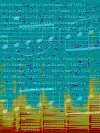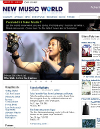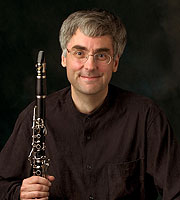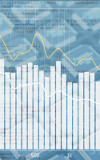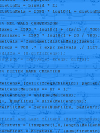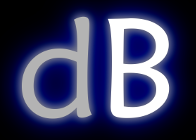
Software
Various Projects
Puzzle Variations

Suzanne Kaprov is an artist who creates among a variety of unique works or art, pieces centered around...well, pieces of puzzles. Her work was deeply influenced by her friendship with John Cage.
"First I take a blank, factory-produced puzzle. After coding the backs of each piece so I can later reassemble them, I then disassemble the puzzle and place the pieces into a bowl. The pieces are mixed as I would shuffle a deck of cards. I then randomly pick a puzzle piece from the bowl, ready for painting. In another separate bowl, I place a hundred individual stickers, each one numbered and labeled with a different (written) color, for a total of one hundred color choices. I select five colors for each piece, one by one, randomly picking them from the bowl. Each sticker is always returned to the bowl, which is re-shuffled again. Once five colors are picked, the individual puzzle piece is ready for painting. I repeat this until all the pieces are done and when the puzzle is reassembled, the completed 'big picture' finally emerges."
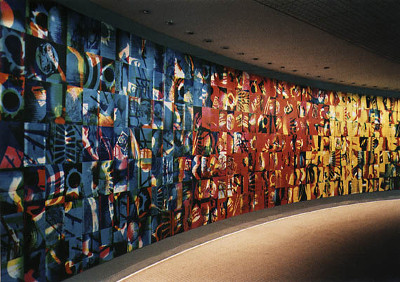
I was asked by Ear to the Earth to use a recorded text of Suzanne speaking 100 words and create a process analogous to her paintings.* My software diced up the recited text, creating an individual audio file for each word. A series of one dozen audio effects exploiting eight channel (3-d) audio were developed. A random number generator selects how many effects are applied, in what order, the values for all of their variables, and the amount of overlap between files. Examples of the "remix" from eight channels down to stereo can be heard here.
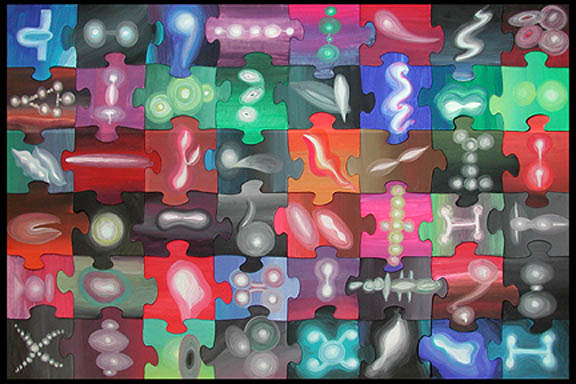
*The process described on the E2E website is not exactly what I used.
New Music World
Beginning in September of 2012, I became involved as the project manager of the development of www.newmusicworld.org- the web arm of a not-for-profit based in New York State. The mission of New Music World, LTD is to foster awareness of the issues, ideas, personalities, and current events in new music throughout the globe. The site offers a consolidated platform for artists and audiences to come together in one place sharing their events, news, and ideas.
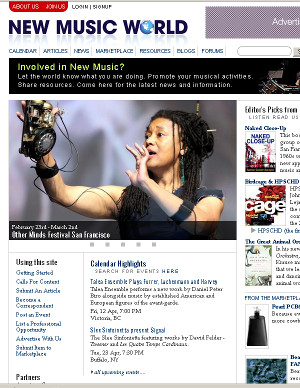
The site itself was built on the Drupal platform, and while there were many challenges technically, managing the written copy, collection of materials, and other aspects of the site proved to be equally as difficult. The site features aspects of professional networking, blogging, a searchable events database, and aggregated news feeds from the web.
Team members involved in development included Orin Buck, Joel Chadabe, Menon Dwarka, Drake Ralph Anderson, and Stephanie Loveless.
In the fall of 2011 I created a program from scratch designed to generate pieces of "tonal" music. My initial work relied on Markov Chains, but I found the results to be rather predictable once a model was decided upon. I then decided to use probabilities with shifting weights in conjunction with random number generation to make all "decisions." The software seeded the piece with initial selections for:
- Scale: Number of notes, interval structure, and root
- Number of "Instruments" and their ranges
- Number of starting instruments and their timbres
System Studies
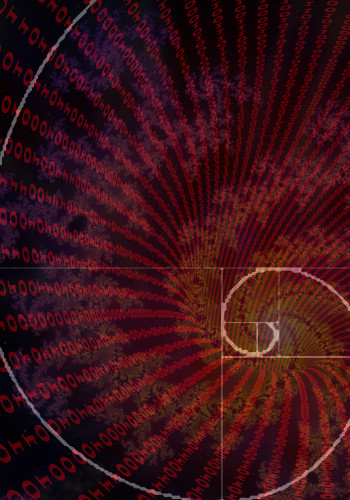
Using the irrational number Phi as a measure of proportion and timekeeping, the system kept running averages of times, frequency of occurrence, and types of previous events in order to change timbres, exchange melodic fragments between voices, modulate, apply frequency and amplitude modulation, and change global as well individual dynamics.
The timbres themselves were generated with a separate wavetable for every pitch executed, giving the instruments the subtle appearance of register found in acoustic instruments. Random number generation was applied continuously to details throughout the process in order to increase subtle complexities, including a random scalar value to every note generated in order to humanize the execution of the dynamics.
The results can be heard under Composition.
Academic Work
Digital Signal Theory
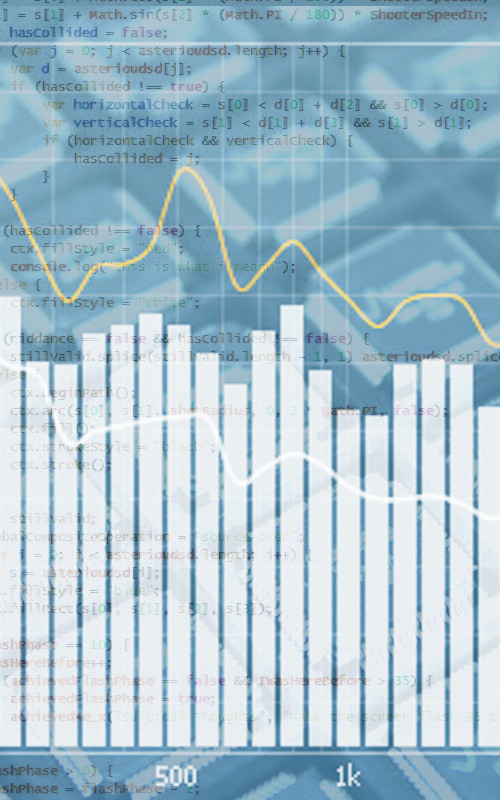
In the fall of 2010 and spring of 2011, I studied Digital Signal Theory with lab instructor Aron Glennon, and classroom instructor Chad Wagner. I completed the following lab projects:
DST I:
- Signal Generator: Digitally generating waveforms using band-limited additive synthesis.
- Spectrum Analyzer: An introduction to the Discrete and Fast Fourier Transforms, and the creation of a tool for visualizing this information.
- Convolution Reverb: Taking impulse responses from the real world and combining them using direct and fast convolution methods.
- Simple Digital Filtering: Creating first order FIR and IIR low and high-pass filters.
DST II:
- Advanced Digital Filters: Creating higher order, shelving, band-pass, and other specialized filters, generating coefficients from scratch.
- Fractional Delay Lines: The creation of audio effects such as flanging, chorus, and other modulation effects using linear and quadratic interpolation.
- Time Syncronous Pitch-Shifting: Examination of various pitch shifting algorithms with emphasis placed on "time-syncronous" methods in order to reduce artifacts in the shifted signal.
- Filterbanks / Vocoding: An overview of filterbanks, phase vocoding and sinusoidal modeling used to generate various cross-filtering and spectrum/envelope altering effects.
- FINAL PROJECT - : Analysis / Resynthesis creating classic synthesizer waveform output using a monophonic acoustic input.
M.I.R. Class Fall '11
In the fall of 2011 I studied Music Information Retrieval with one of the leading experts in the field, Dr. Juan Bello. I completed the following projects in MATLAB:
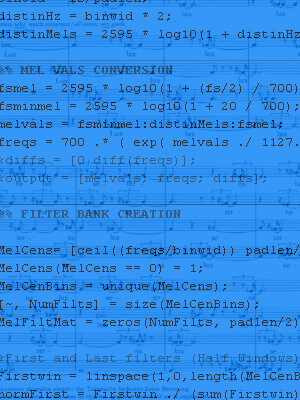
- Spectral Analysis and DFT Calculation: A refresher in spectrograms and a "manual" calculation of the Discrete Fourier Transform.
- Onset and Tempo Detection: Methods of detecting the start of musical events utilizing amplitude envelope following as well as spectral flux, coupled with methods for grouping onsets in order to find pulse, meter, and tempo in music.
- Chord Identification Using Chroma Vectors: Identifying chords using Chroma vectors generated from 36-bin per octave spectral filtering. Bins from all octaves are folded into 12 pitch class sets and matched to templates based on correlation.
- Instrument Classification: Comparison of a test set of Mel Frequency Cepstral Coefficients (MFCCs) gathered from recordings of solo instruments, and compared against varied sizes of training sets containing known MFCCs via Euclidean Distance.
- Harmonic Transcription Using Chroma Vectors: A final project with partner Alan Johnson, attempting to convert digital audio into standard chord charts, such as what would be seen in the Real Book.
CURRENT:
My programming work centers around two things: DSP software for hardware (MCUs) and
applying the results of my
Master's Thesis
findings, using Will Pirkle's
Rack-FX,
an API for creating VST plug-ins.
Although C/C++ are my primary languages, I still exercise with Matlab/Octave working on DSP algorithms and proof of concept tests.
Working on
New Music World
, I also gained skills in
CSS and HTML, and have some familiarity with .js, jQuery, SVG, and Drupal.
BACKGROUND AND EXPERIENCE:
My introduction to programming goes back to BASIC and Logo on the Apple iie as a child, but my interest in
interactive media sparked my current track into programming, starting with MAX/MSP 4.2.
Learning MAX independently gave me insights into synthesis, MIDI, and audio processing, and
these, among other curiosities, lead to my Graduate Studies in NYU's Music Technology Program.
In M.Tech, MatLab was the de facto language, and I concentrated on Digital Audio Processing (DAP), Digital Signal Processing (DSP), and Music Information Retrieval (MIR). My performance as a student earned me a slot as a department tutor, and later the annual "Outstanding Graduate Student in M.Tech" award. System theory and artificial creativity have been two running themes in my software work.
